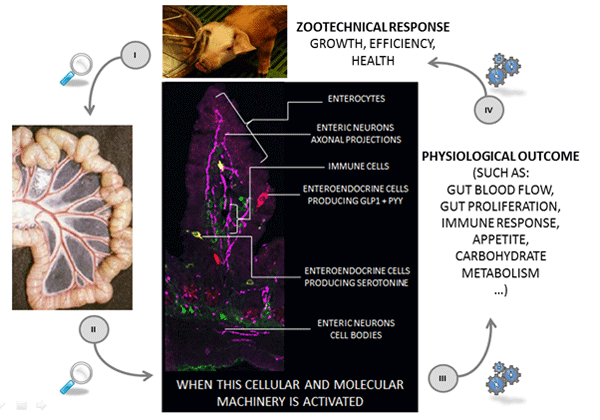Role of the gut physiology in animal feeding
Published: June 15, 2014
By: Dr. Emma Wall (Deputy Director research and development of Pancosma)
And by Dr. David Bravo (Director and head of research and development of Pancosma)
New research findings in gut physiology: implications for animal feeding
Recently, a paper was published in the scientific journal Nature Reviews1 entitled “The gut as a sensory organ.” As the title suggests, scientists are now considering the gut literally as an intelligent sensory organ, with the ability to “sense” its environment and react to it. What does this mean, and why should animal nutritionists be interested? Surprisingly, the connection to animal feeding is closer than one might expect. Read on to find out.
Gut sensing defined
The gastrointestinal tract of animals is the largest tissue surface that is exposed to the external environment including nutrients, bacteria, and toxins. The contents of the gut are continuously changing, modified by ingestion of food and drink, as well as pathogens and toxins from the outside environment. The only thing that separates the gut from the rest of the body is a single layer of epithelial cells. These specific cells (eg. enteroendocrine cells, dendritic cells) constantly monitor the contents of the gut and communicate with other systems of the body to prepare them for what’s coming – to adjust ingestion, prime organs for nutrient digestion, and reject toxins – and it does so using immune, endocrine and neural signals. In fact, the gut contains the majority of the immune cells in the body, the most extensive nervous system, and the largest endocrine system.
For example, the enteroendocrine cells express molecular nutrient or non-nutrient sensors that cause the cells to release hormones when they are triggered by the right
compound. These hormones will then elicit physiological changes in the animal such as changes in feed intake or retention of food within the gut (transit time), release of digestive enzymes, secretion of insulin, immune responses, and tissue growth (Figure 1; used with permission by Dr. John Furness, University of Melbourne, Australia). For example, an increase in fat in the small intestine causes the secretion of amylases, proteases, and lipases from the pancreas. Therefore, the mere presence of fat is sensed by the cells in the gut, which stimulate the release of hormones to promote digestion of all the major components of food. Some gut sensors also have the ability to detect taste compounds (sweet, umami, and bitter); others can sense non-nutrients such as phytonutrients including capsaicin (from chili peppers) and cinnamaldehyde (from cinnamon).
Implications for animal feeding
What are the consequences of these findings for animal feeding, and how can we use this information to improve animal nutrition? First, it is now appreciated that the gut is a regulatory organ, despite previous thoughts that it was involved only in digestion and absorption. This shatters the old dogma and introduces an entirely new paradigm, and all the possibilities that come with it. There is clearly the potential to develop technologies to target specific sensors in the gut to alter feed intake and feed efficiency, immunity, and gut function. For example, in addition to the effect of fat in the gut on the secretion of digestive enzymes, it also causes the release of satiety factors that can regulate feed intake. Other sensors can trigger insulin secretion and potentially alter glucose and lipid metabolism, key factors in determining milk production efficiency of dairy cows. The immune system is also a
potential target: bacteria entering the gut have clearly established roles in both the efficiency of nutrient digestion and absorption, as well as the development of the immune system. Therefore, although research linking novel findings in gut physiology to animal feeding is still in its infancy, there are clear and promising opportunities to improve and refine current animal feeding strategies.
An important finding that was originally observed in swine but has high relevance for ruminant nutrition is the manipulation of gut sweet taste receptors. Upon tasting sweet (animals supplemented with the artificial sweetener SUCRAM®), these receptors trigger the release of a gut hormone that eventually enhances the uptake of glucose by the gut (see Feedstuffs Vol. 84, No. 12, p. 1). The same molecular and cellular machinery as well as the response have now been seen in both milk-fed and weaned calves, as well as in dairy cows. This has obvious implications for both calves and adult ruminants as it could potentially improve feed efficiency, and decrease the incidence of ketosis in transition cows. .
The response of the gut of both pigs and calves to artificial sweetener is mediated by the gut hormone called glucagon-like peptide-2 (GLP-2). This hormone is involved in tissue repair and increases blood flow to the gut, which can improve digestion and absorption of nutrients in addition to preventing or repairing damage (see Figure 1). Supplementing pigs with SUCRAM® around weaning improves the integrity of the gut and prevents the damage associated with decreased feed intake. Injection of GLP-2 is already used as a therapy for Crohn’s disease in humans, so there is obvious potential that feeding artificial sweeteners to ruminants could improve gut function – especially during weaning – of calves, and also of cows with Johne’s disease.
In summary, recent progress in the area of gut physiology has revealed novel roles for the gut in regulating the function of other systems – including the endocrine, immune, and nervous systems – and these newly established relationships have clear implications for animal feeding. The key findings are:
- The gut is exposed to a wide range of nutrients, chemicals, and organisms from the external environment.
- The gut is continuously monitoring its contents to enable digestion and absorption of nutrients, and to ward off pathogens.
- Specialized cells of the gut contain “sensors” that can detect nutrients, non-nutrients, distension/expansion, microorganisms, and toxins.
- The sensory information is communicated from the gut to the endocrine, neural, and immune systems.
- Many of the receptors expressed on these gut cells are potential targets for feed additives aimed at altering nutrient metabolism and absorption, feed intake, body weight, and gut health/repair.
Research in gut physiology, although it does not appear at first glance to be directly linked to animal feeding, has the potential to revolutionize animal feeding as we know it today. As scientists better understand how the function of digestive organs – and their downstream targets – can be altered, doors will be opened for a potential technological boom in animal feeding. Such advances include the use of highly sophisticated and targeted feed additives, the use of feed additives as therapeutics and/or preventative management tools to optimize gut health and function, and to target specific digestive processes with unprecedented precision.
Reference:
1. Furness, J.B., L.R. Rivera, H.J. Cho, D.M. Bravo, and B. Callaghan. 2013. The gut as a sensory organ. Nature Reviews. Gastroenterology & Hepatology.
Figure 1. The gut as a sensory organ: the new link between gut physiology and animal performance

Related topics:
Authors:
Nutreco
Recommend
Comment
Share
2 de julio de 2014
Very good artical but research should also be done in examining the parameters of gut efficient regarding disease control . I think GIT is the most important organ in disease prevention weather those are digestive ,reproductive or respiratory system diseases . Your views about this ?
Recommend
Reply
28 de junio de 2014
this is quite interesting article. Long back it was known the digestive system was for digesting food and assimulation of nutrients ,its also an immune organ which control the toxins that get into the body
Recommend
Reply
Recommend
Reply
Recommend
Reply

Would you like to discuss another topic? Create a new post to engage with experts in the community.













.jpg&w=3840&q=75)